概述:
- 算法主要是由头文件<algorithm> <functional> <numeric>组成。
- <algorithm>是所有STL头文件中最大的一个,范围涉及到比较、 交换、查找、遍历操作、复制、修改等等
- <numeric>体积很小,只包括几个在序列上面进行简单数学运算的模板函数
- <functional>定义了一些模板类,用以声明函数对象。
1、常用遍历算法
1.1、for_each
功能描述:
- 实现容器的遍历
函数原型:
- for_each(iterator beg, iterator end, _func);
// beg 开始迭代器
// end 结束迭代器
// _func 函数或者函数对象
示例:
#include<vector>
#include<algorithm>
//常用遍历算法 for_each
void print01(int val) {
cout << val << " ";
}
class Print02 {
public:
void operator()(int val) const {
cout << val<<" ";
}
};
void test01() {
int a[] = { 1,2,4,5,6,7,8,0,9 };
vector<int> v(a,a+9);
//用函数名,作为第三个参数
for_each(v.begin(), v.end(),print01);
cout << endl;
//用仿函数,作为第三个参数
//Print02() 匿名对象
for_each(v.begin(), v.end(),Print02());
cout << endl;
}
int main() {
test01();
system("pause");
return 0;
}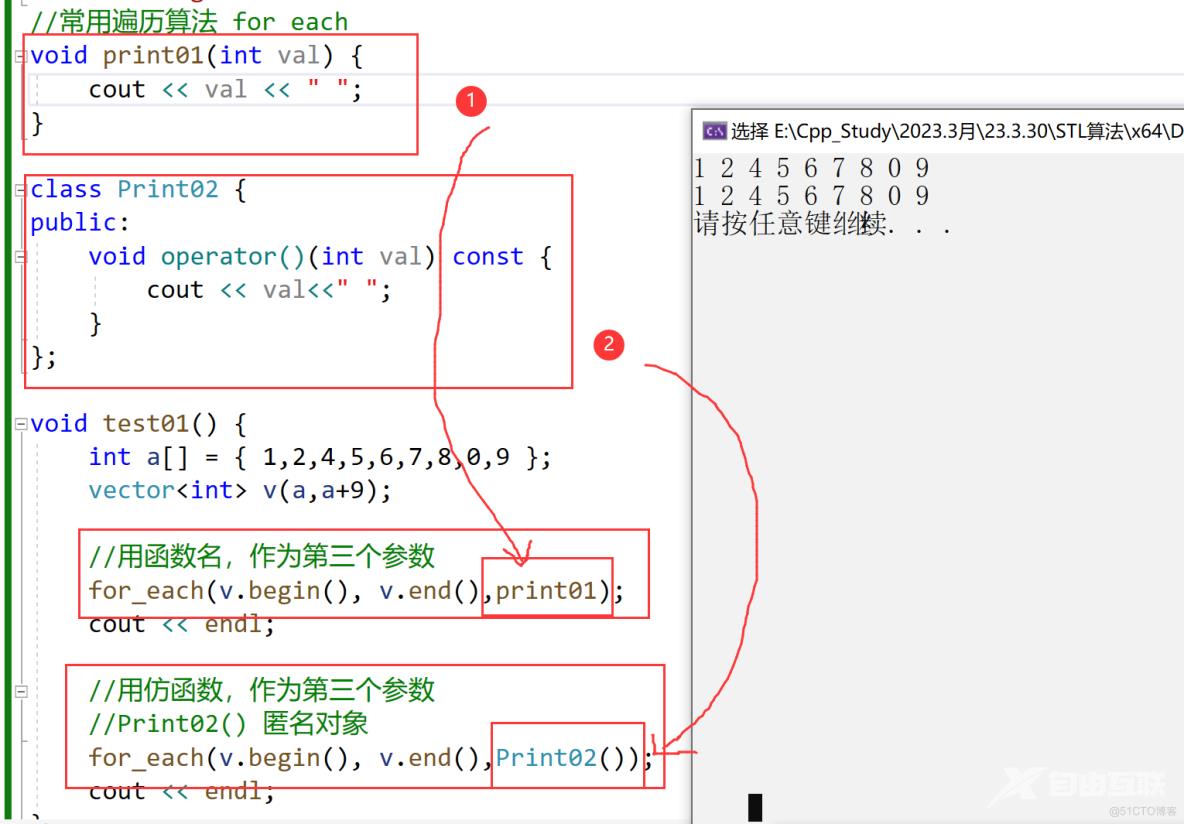
1.2、transform
功能描述:
- 搬运容器到另一个容器中
函数原型:
- transform(iterator beg1, iterator end1, iterator beg2, _func);
//beg1 源容器开始迭代器
//end1 源容器结束迭代器
//beg2 目标容器开始迭代器
//_func 函数或者函数对象
示例:
//常用遍历算法 transform
class Print02 {
public:
int operator()(int val) const {
cout << val << " ";
return val;
}
};
int func(int val) {
return val;
}
void test01() {
int a[] = { 1,2,4,5,6,7,8,0,9 };
//1、源容器
vector<int> vS(a, a + 9);
for_each(vS.begin(), vS.end(), Print02());
cout << endl;
//2、目标容器
vector<int> vT;
vT.resize(vS.size());//开辟空间,不开辟报错、
//搬运
transform(vS.begin(),vS.end(),vT.begin(),func);
for_each(vT.begin(),vT.end(),Print02());
cout << endl;
//搬运时,对_func赋予功能——打印输出
transform(vS.begin(),vS.end(),vT.begin(),Print02());
cout << endl;
}
int main() {
test01();
system("pause");
return 0;
}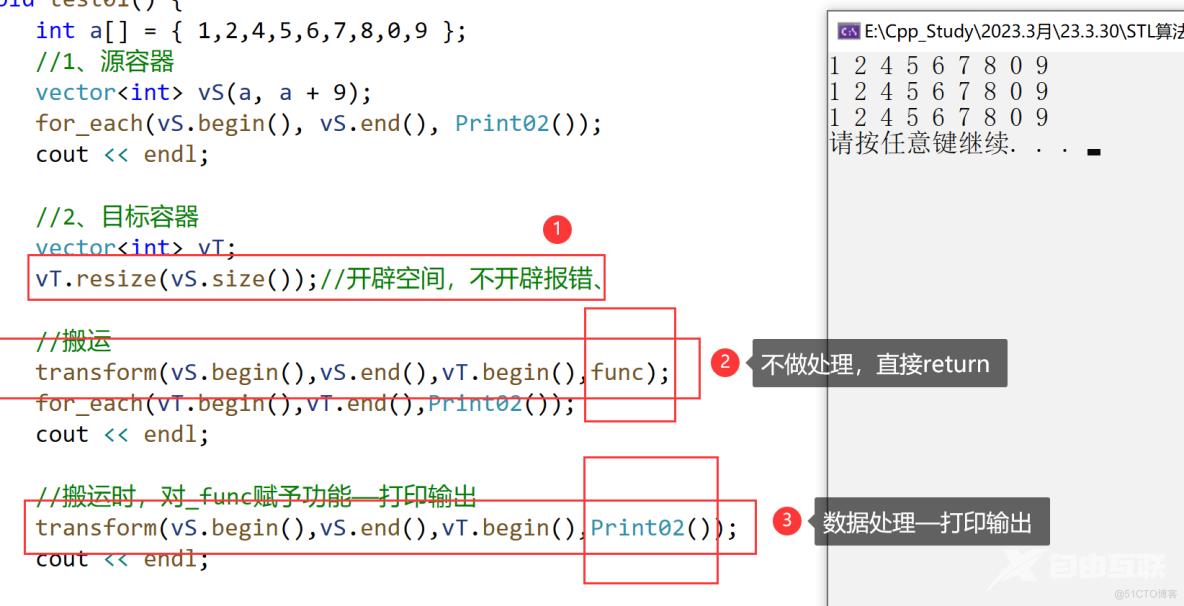
注意事项:
1、目标容器需要提前开辟空间(resize),否则无法搬运!
2、第四个参数(_func),用于对数据进行一定的变换或输出,如果不变换或输出,直接return
3、第四个参数(_func),需要返回值,不可以是void
2、常用查找算法
2.1、find
功能描述:
- 查找指定元素,找到返回指定元素的迭代器,找不到返回结束迭代器end()
函数原型:
- find(iterator beg, iterator end, value);
- // beg 开始迭代器
- // end 结束迭代器
- // value 查找的元素
示例:
//常用的查找算法 find
class Print01 {
public:
void operator()(int val) {
cout << val << " ";
}
};
//1、查找内置数据类型
void test01() {
int a[] = { 1,2,6,7,8,3,4,5,9 };
vector<int> v(a,a+(sizeof(a)/sizeof(a[0])));
for_each(v.begin(),v.end(),Print01());
cout << endl;
vector<int>::iterator it = find(v.begin(),v.end(),10);
if (it == v.end()) {
cout << "内置数据类型 未找到" << endl;
}
else {
cout << "内置数据类型 找到了 : " <<*it<< endl;
}
}
//2、查找自定义数据类型
class Person {
public:
//初始化列表,构造函数
Person(string name, int age) :m_name(name), m_age(age) {}
//重载 == ,让底层find知道怎么去比较
bool operator==(const Person& p) {
if (this->m_name == p.m_name && this->m_age == p.m_age) {
return true;
}
else
return false;
}
string m_name;
int m_age;
};
class Print02 {
public:
void operator()(Person p) {
cout << "姓名:" << p.m_name << " 年龄:" << p.m_age << endl;
}
};
void test02() {
vector<Person> vp;
Person p1("aaa", 10);
Person p2("bbb", 20);
Person p3("ccc", 30);
vp.push_back(p1);
vp.push_back(p2);
vp.push_back(p3);
for_each(vp.begin(), vp.end(), Print02());
Person pp("aaa",10);
vector<Person>::iterator it1 = find(vp.begin(),vp.end(),pp);
if (it1 == vp.end()) {
cout << "自定义数据类型 未找到" << endl;
}
else {
cout << "自定义数据类型 找到了 : " << endl;
cout << "姓名:" << it1->m_name << " 年龄:" << it1->m_age << endl;
}
}
int main() {
test01();
cout << endl;
test02();
system("pause");
return 0;
}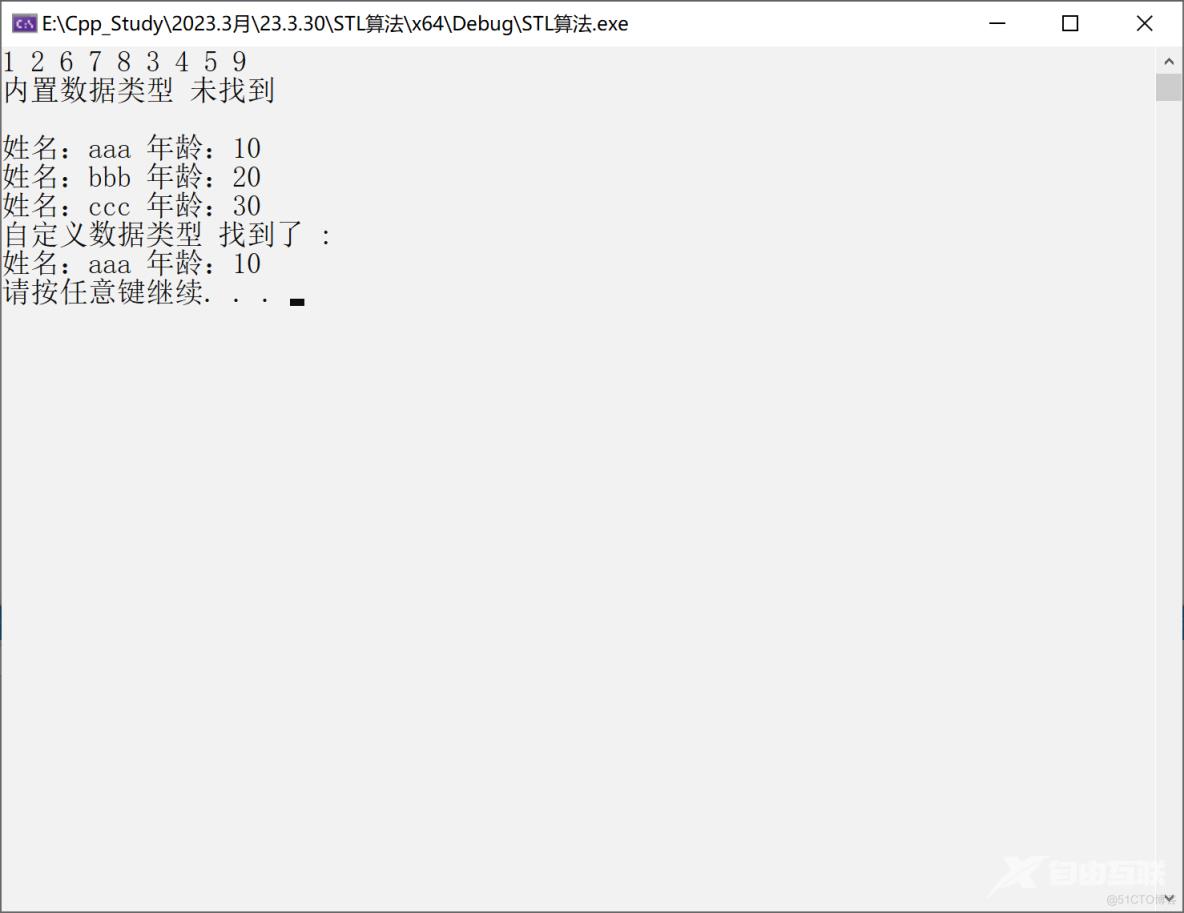
注意事项:
1、查找自定义数据类型时,需要重载==,让底层find知道如何去比较数据是否相等
2、利用find可以在容器中找指定的元素,返回值是迭代器
2.2、find_if
功能描述:
- 按值查找元素,找到返回指定位置迭代器,找不到返回结束迭代器位置
函数原型:
- find_if(iterator beg, iterator end, _Pred);
// beg 开始迭代器
// end 结束迭代器
// _Pred 函数或者谓词(返回bool类型的仿函数)
示例:
//常用的查找算法 find_if
class Print01 {
public:
void operator()(int val) {
cout << val << " ";
}
};
class greater5 {
public:
bool operator()(int val) {
return val > 5;
}
};
//1、查找内置数据类型
void test01() {
int a[] = { 1,2,6,7,8,3,4,5,9 };
vector<int> v(a, a + (sizeof(a) / sizeof(a[0])));
for_each(v.begin(), v.end(), Print01());
cout << endl;
vector<int>::iterator it = find_if(v.begin(), v.end(), greater5());
if (it == v.end()) {
cout << "内置数据类型 未找到" << endl;
}
else {
cout << "内置数据类型 找到了 : " << *it << endl;
}
}
//2、查找自定义数据类型
class Person {
public:
//初始化列表,构造函数
Person(string name, int age) :m_name(name), m_age(age) {}
string m_name;
int m_age;
};
class Print02 {
public:
void operator()(Person p) {
cout << "姓名:" << p.m_name << " 年龄:" << p.m_age << endl;
}
};
class greater20 {
public:
bool operator()(Person p) {
return p.m_age > 20;
}
};
void test02() {
vector<Person> vp;
Person p1("aaa", 10);
Person p2("bbb", 20);
Person p3("ccc", 30);
vp.push_back(p1);
vp.push_back(p2);
vp.push_back(p3);
for_each(vp.begin(), vp.end(), Print02());
vector<Person>::iterator it1 = find_if(vp.begin(), vp.end(), greater20());
if (it1 == vp.end()) {
cout << "自定义数据类型 未找到" << endl;
}
else {
cout << "自定义数据类型 找到了 : " << endl;
cout << "姓名:" << it1->m_name << " 年龄:" << it1->m_age << endl;
}
}
int main() {
test01();
cout << endl;
test02();
system("pause");
return 0;
}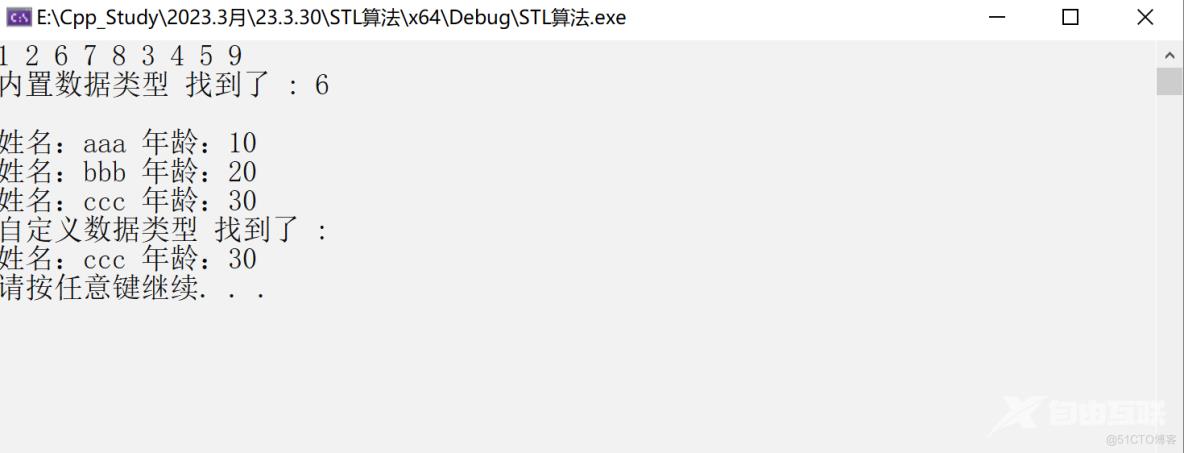
2.3、adjacent_find
功能描述:
- 查找相邻重复元素,返回相邻元素的第一个位置的迭代器
函数原型:
- adjacent_find(iterator beg, iterator end);
// beg 开始迭代器
// end 结束迭代器
示例:
//常用查找算法 adjacent_find
class printVector {
public:
void operator()(int val) {
cout << val << " ";
}
};
void test01() {
vector<int> v;
v.push_back(10);
v.push_back(20);
v.push_back(30);
v.push_back(10);
v.push_back(10);
for_each(v.begin(),v.end(),printVector());
cout << endl;
vector<int>::iterator it = adjacent_find(v.begin(),v.end());
if (it == v.end()) {
cout << "未找到相邻元素" << endl;
}
else {
cout << "相邻元素:" << *it << endl;
}
}
int main() {
test01();
system("pause");
}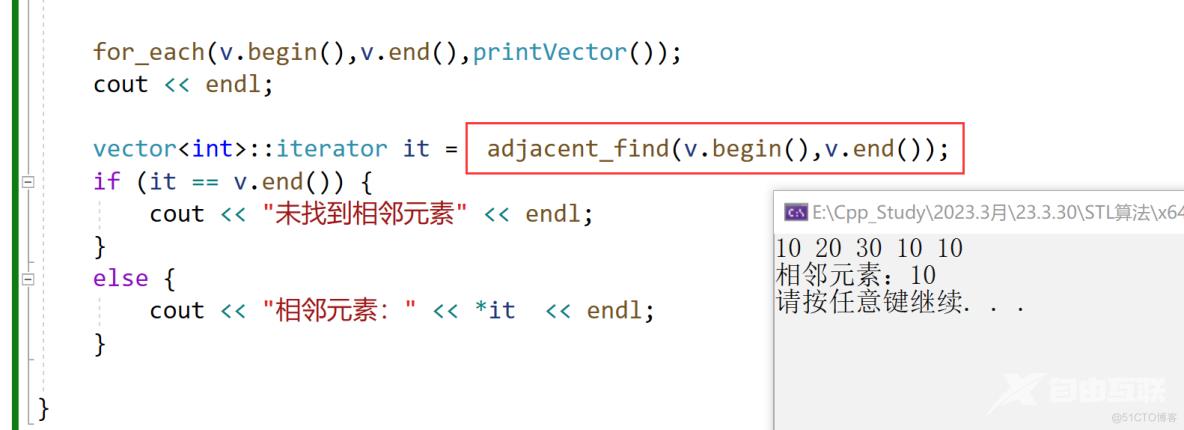
总结:面试题中如果出现查找相邻重复元素,记得用STL中的adjacent_find算法
2.4、binary_search
功能描述:
- 二分查找法,查找指定的元素,查到 返回true 否则false
函数原型:
- bool binary_search(iterator beg, iterator end, value);
// beg 开始迭代器
// end 结束迭代器
// value 查找的元素
示例:
//常用的查找算法 binary_search
void test01() {
vector<int> v;
for (int i = 0; i < 10;i++) {
v.push_back(i);
}
for (vector<int>::iterator it = v.begin(); it != v.end();it++) {
cout << *it << " ";
}
cout << endl;
bool ret = binary_search(v.begin(),v.end(),9);
if (ret) {
cout << "找到了9" << endl;
}
else
cout << "未找到9" << endl;
}
int main(){
test01();
system("pause");
}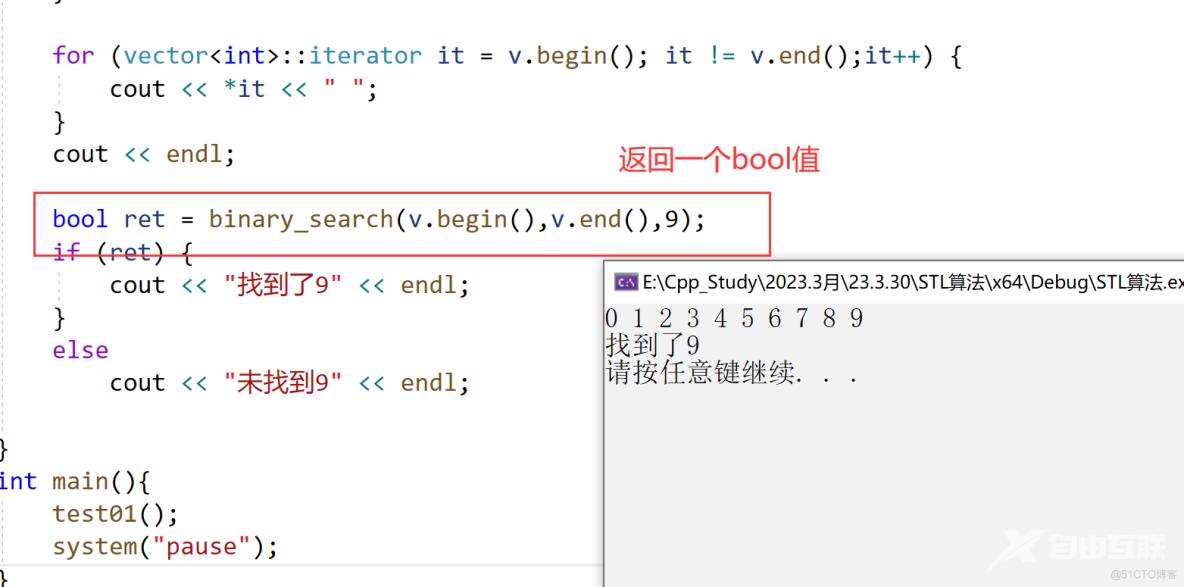
注意事项:
1、二分查找, 仅在有序序列中可用,如果是无序序列,结果未知
2、二分查找法的查找效率很高
2.5、count
功能描述:
- 统计元素出现次数
函数原型:
- count(iterator beg, iterator end, value);
- // beg 开始迭代器
- // end 结束迭代器
- // value 统计的元素
示例:
//常用查找算法 count(统计)
//1、内置数据类型
void test01() {
vector<int> v;
v.push_back(10);
v.push_back(20);
v.push_back(10);
v.push_back(30);
for (int i = 0; i < v.size();i++) {
cout << v[i] << " ";
}
cout << endl;
int ret = count(v.begin(),v.end(),10);
cout << "自定义数据类型—10 的个数:" << ret << endl;
}
//2、自定义数据类型
class Person {
public:
Person(string name, int age) {
this->m_name = name;
this->m_age = age;
}
//重载 ==
bool operator==(const Person& p) {
if (p.m_age == this->m_age) {
return true;
}
else
return false;
}
string m_name;
int m_age;
};
void test02() {
vector<Person> vp;
Person p1("刘备",30);
Person p2("关羽",30);
Person p3("张飞",30);
Person p4("小乔",20);
Person p5("周瑜",40);
vp.push_back(p1);
vp.push_back(p2);
vp.push_back(p3);
vp.push_back(p4);
vp.push_back(p5);
Person p9("诸葛",30);
vector<Person>::iterator it = vp.begin();
for (int i = 0; i < vp.size();i++) {
cout << "姓名:" << it->m_name << " 年龄:" << it->m_age << endl;
it++;
}
int ret1 = count(vp.begin(),vp.end(),p9);
cout << "和诸葛年龄相同的人个数:" << ret1 << endl;
}
int main() {
test01();
cout << endl;
test02();
system("pause");
}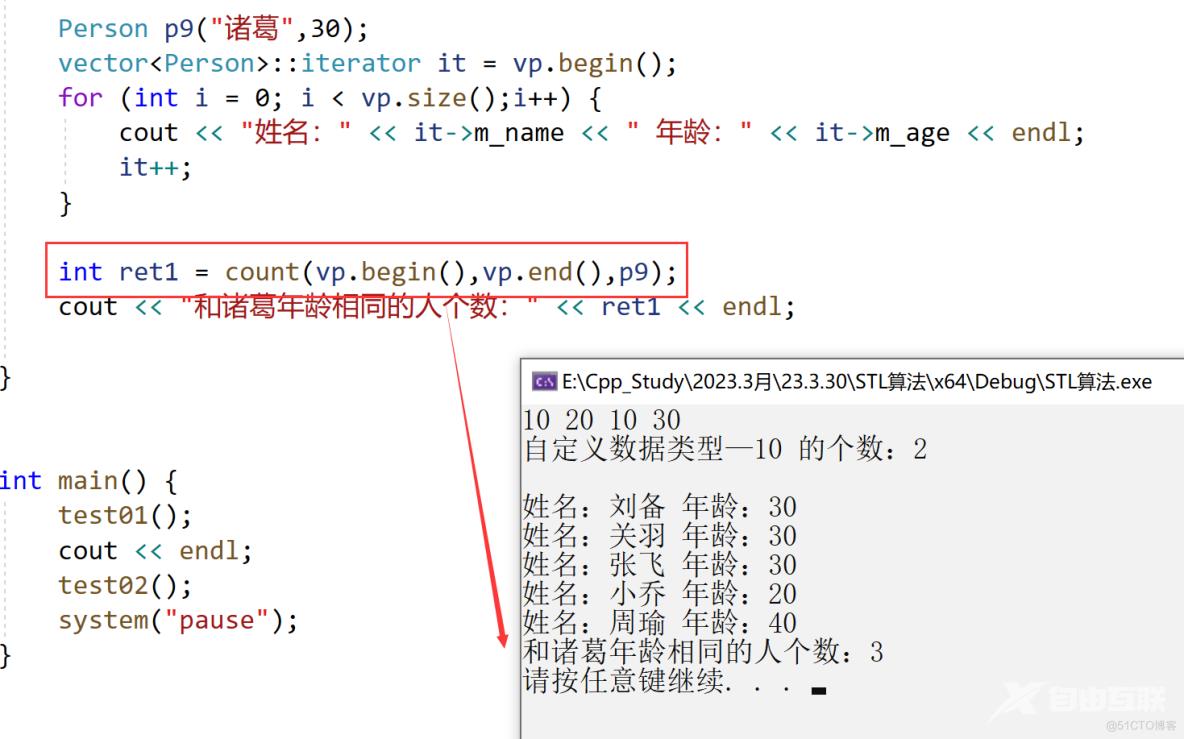
注意事项:对于统计自定义数据类型的时候,需要配合重载operator==
2.6、count_if
功能描述:
- 按条件统计元素出现次数
函数原型:
- count_if(iterator beg, iterator end, _Pred);
// beg 开始迭代器
// end 结束迭代器
// _Pred 谓词
示例:
//常用查找算法 count_if(条件统计)
class greater5 {
public:
bool operator()(int val) {
return val > 10;
}
};
//1、内置数据类型
void test01() {
vector<int> v;
v.push_back(10);
v.push_back(20);
v.push_back(10);
v.push_back(30);
for (int i = 0; i < v.size(); i++) {
cout << v[i] << " ";
}
cout << endl;
int ret = count_if(v.begin(), v.end(),greater5());
cout << "内置数据类型—大于5的个数:" << ret << endl;
}
//2、自定义数据类型
class Person {
public:
Person(string name, int age) {
this->m_name = name;
this->m_age = age;
}
string m_name;
int m_age;
};
class greater20 {
public:
bool operator()(const Person& p) {
return p.m_age > 20;
}
};
void test02() {
vector<Person> vp;
Person p1("刘备", 30);
Person p2("关羽", 30);
Person p3("张飞", 30);
Person p4("小乔", 20);
Person p5("周瑜", 40);
vp.push_back(p1);
vp.push_back(p2);
vp.push_back(p3);
vp.push_back(p4);
vp.push_back(p5);
vector<Person>::iterator it = vp.begin();
for (int i = 0; i < vp.size(); i++) {
cout << "姓名:" << it->m_name << " 年龄:" << it->m_age << endl;
it++;
}
int ret1 = count_if(vp.begin(), vp.end(), greater20());
cout << "自定义数据类型—年龄大于20:" << ret1 << endl;
}
int main() {
test01();
cout << endl;
test02();
system("pause");
}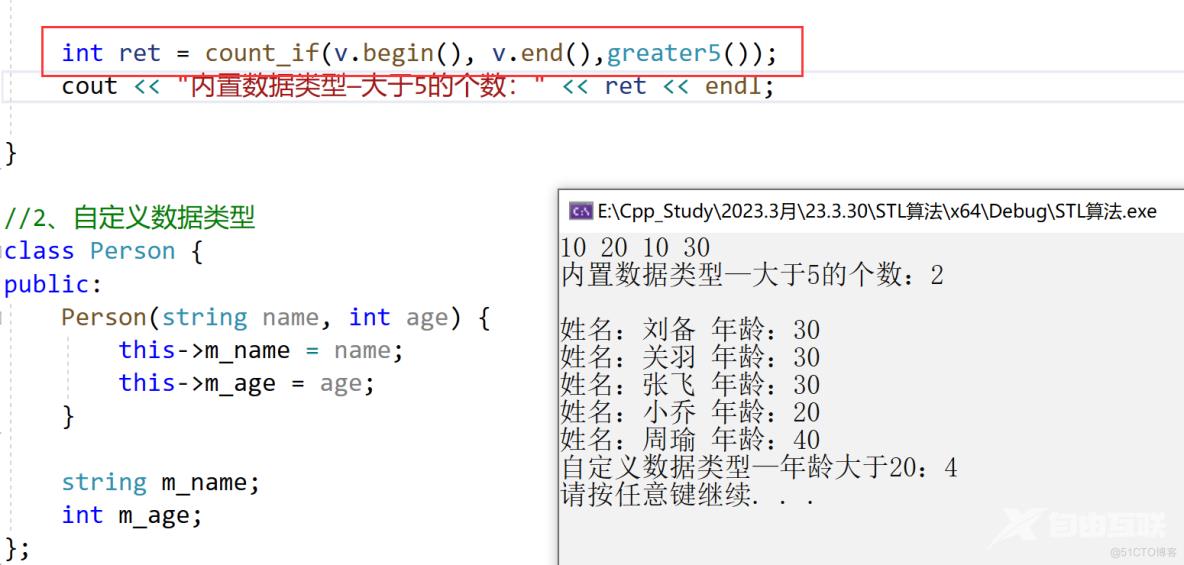
3、常用排序算法
3.1、sort
功能描述:
- 对容器内元素进行排序
函数原型:
- sort(iterator beg, iterator end, _Pred);
// beg 开始迭代器
// end 结束迭代器
// _Pred 谓词
示例:
//常用排序算法 sort
void print01(int val) {
cout << val << " ";
}
class myCompera {
public:
bool operator()(int val1,int val2) {
return val1 > val2;
}
};
void test01() {
vector<int> v;
v.push_back(10);
v.push_back(50);
v.push_back(20);
v.push_back(30);
v.push_back(40);
for_each(v.begin(),v.end(), print01);
cout << endl;
//1、默认升序
sort(v.begin(),v.end());
for_each(v.begin(), v.end(), print01);
cout << endl;
//2、使用内置函数对象,改变规则为降序
sort(v.begin(),v.end(),greater<int>());
for_each(v.begin(), v.end(), print01);
cout << endl;
//3、自定义谓词,改变排序规则
sort(v.begin(), v.end(),myCompera());
for_each(v.begin(), v.end(), print01);
cout << endl;
}
int main() {
test01();
system("pause");
return 0;
}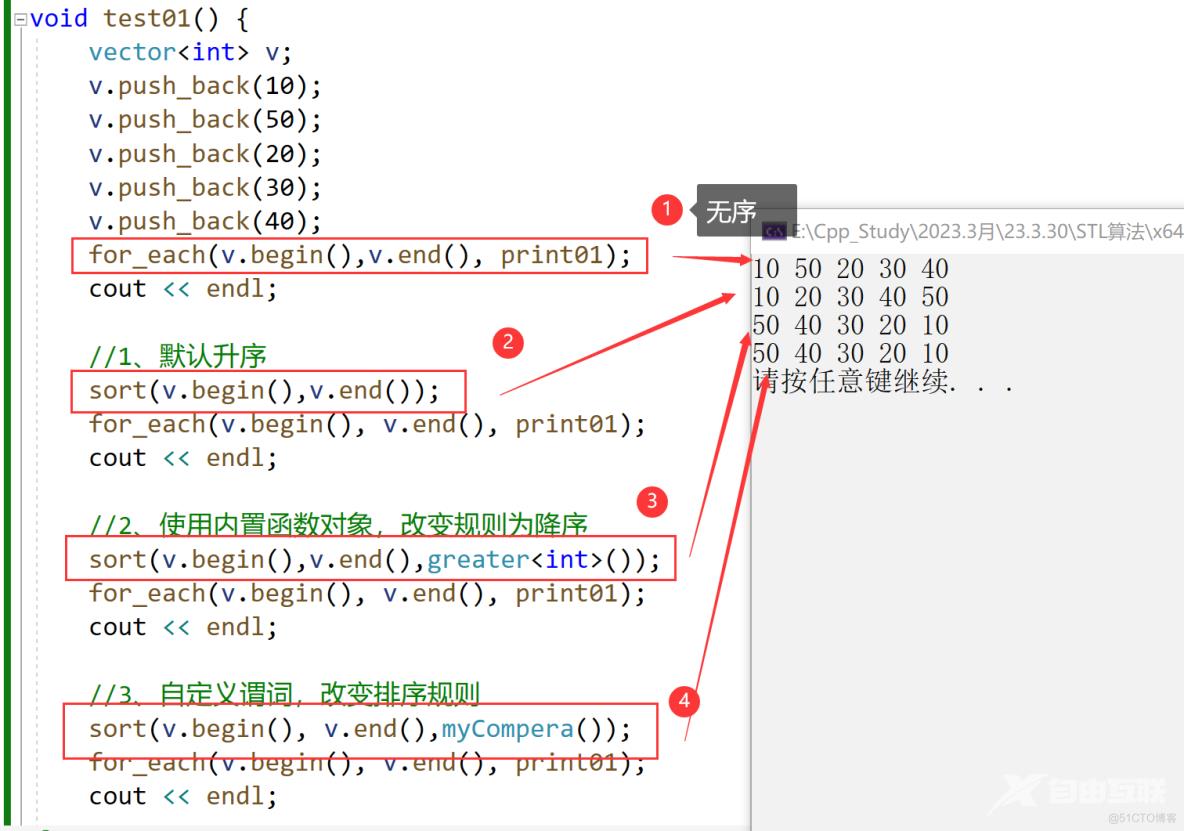
3.2、random_shuffle
功能描述:
- 洗牌 指定范围内的元素随机调整次序
函数原型:
- random_shuffle(iterator beg, iterator end);
// beg 开始迭代器
// end 结束迭代器
示例:
//常用排序算法 random_shuffle
void print01(int val) {
cout << val << " ";
}
class myCompera {
public:
bool operator()(int val1, int val2) {
return val1 > val2;
}
};
void test01() {
//随机数的种子
srand((unsigned int)time(NULL));
vector<int> v;
for (int i = 0; i < 10;i++) {
v.push_back(i);
}
for_each(v.begin(),v.end(),print01);
cout << endl;
//洗牌,打乱顺序
random_shuffle(v.begin(),v.end());
for_each(v.begin(), v.end(), print01);
cout << endl;
}
int main() {
test01();
system("pause");
return 0;
}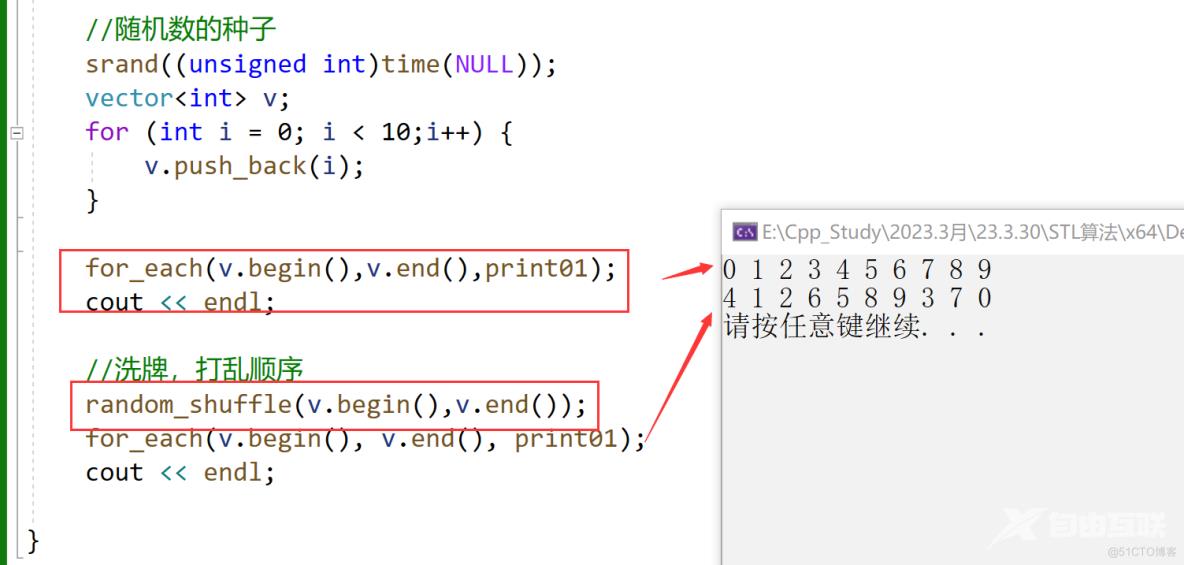
注意事项:如果想要多次执行单个random_shuffle,并且每次执行的打乱顺序不一致,需要加入随机数的种子
3.3、merge
功能描述:
- 两个容器元素合并,并存储到另一容器中
函数原型:
- merge(iterator beg1, iterator end1, iterator beg2, iterator end2, iterator dest);
// beg1 容器1开始迭代器
// end1 容器1结束迭代器
// beg2 容器2开始迭代器
// end2 容器2结束迭代器
// dest 目标容器开始迭代器
示例:
//常用排序算法 merge
void print01(int val) {
cout << val << " ";
}
void test01() {
//1、准备两个原容器
vector<int> v1;
vector<int> v2;
for (int i = 10; i > 0; i--) {
v1.push_back(i);
v2.push_back(i-1);
}
for_each(v1.begin(),v1.end(),print01);
cout << endl;
for_each(v2.begin(), v2.end(), print01);
cout << endl;
//2、准备一个目标容器
vector<int> vt;
//3、提前分配空间,否则无法执行
vt.resize(v1.size() + v2.size());
//5、默认升序,可设置为,降序
//注意,两个原容器的排序规则必须和merge的排序规则一致,否则无法执行
merge(v1.begin(),v1.end(),v2.begin(),v2.end(),vt.begin(),greater<int>());
for_each(vt.begin(), vt.end(), print01);
cout << endl;
}
int main() {
test01();
system("pause");
}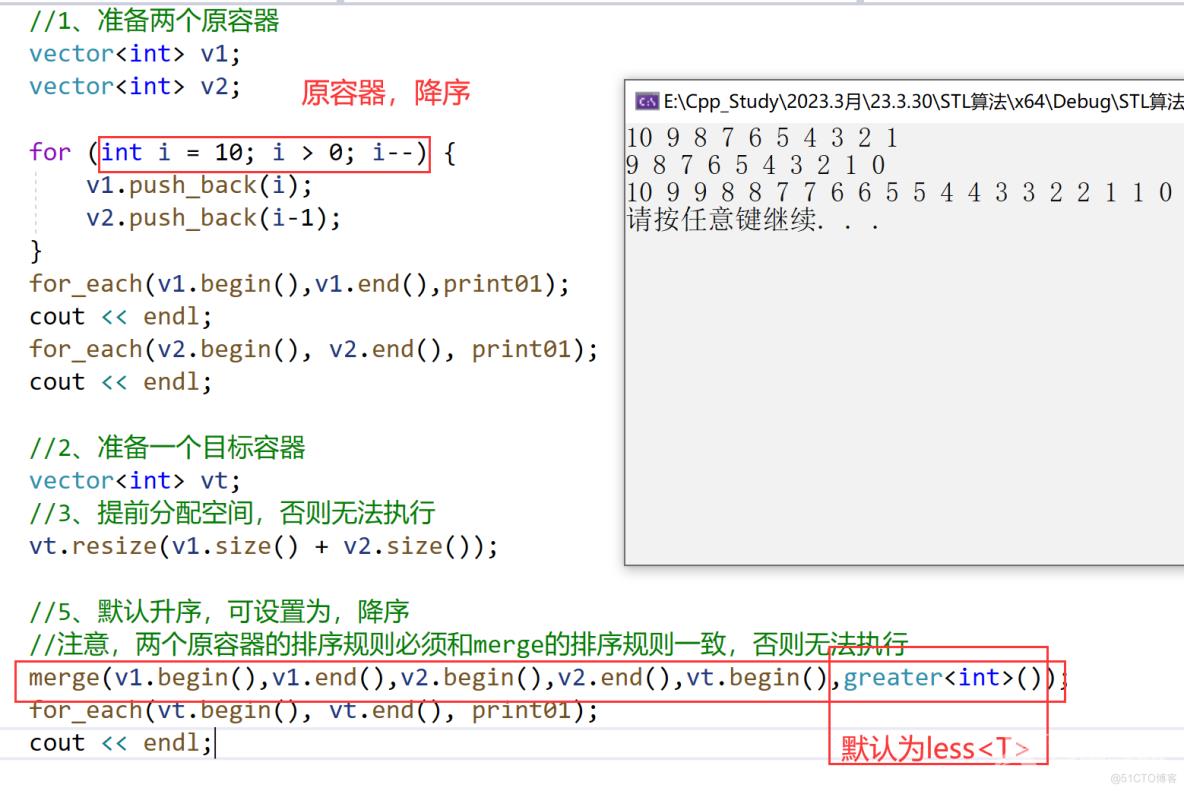
注意事项:
1、 两个容器必须是有序的
2、两个原容器的排序规则必须和merge的排序规则一致,否则无法执行(都是less<T>,或者greater<T>)
3.4、reverse
功能描述:
- 将容器内元素进行反转
函数原型:
- reverse(iterator beg, iterator end);
// beg 开始迭代器
// end 结束迭代器
示例:
//常用排序算法 reverse
void test01() {
vector<char> v;
v.push_back('a');
v.push_back('b');
v.push_back('c');
v.push_back('d');
v.push_back('e');
cout << "反转前:" << endl;
for (int i = 0; i < v.size();i++) {
cout << v[i] << " ";
}
cout << endl;
//反转
reverse(v.begin(),v.end());
cout << "反转后:" << endl;
for (int i = 0; i < v.size(); i++) {
cout << v[i] << " ";
}
cout << endl;
}
int main() {
test01();
system("pause");
}
4、常用拷贝和替换算法
4.1、copy
功能描述:
- 容器内指定范围的元素拷贝到另一容器中
函数原型:
- copy(iterator beg, iterator end, iterator dest);
// beg 开始迭代器
// end 结束迭代器
// dest 目标起始迭代器
示例:
//常用的拷贝算法 copy
void myPrint(int val) {
cout << val << " ";
}
void test01() {
vector<int> v;
for (int i = 0; i < 5;i++) {
v.push_back(i);
}
for_each(v.begin(),v.end(),myPrint);
cout << endl;
vector<int> v2;
v2.push_back(6);
v2.push_back(7);
v2.resize(v.size() + 2);
//拷贝
copy(v.begin(), v.end(),v2.begin()+2);
for_each(v2.begin(), v2.end(), myPrint);
cout << endl;
}
int main() {
test01();
system("pause");
return 0;
}
注意事项:
1、拷贝前,目标容器需要提前分配好空间
2、利用copy,可以实现拼接
4.2、replace
功能描述:
- 将容器内指定范围的所有旧元素修改为新元素
函数原型:
- replace(iterator beg, iterator end, oldvalue, newvalue);
// beg 开始迭代器
// end 结束迭代器
// oldvalue 旧元素
// newvalue 新元素
示例:
//常用的替换算法 replace
class myPrint {
public:
void operator()(int val){
cout << val << " ";
}
};
void test01() {
vector<int> v;
v.push_back(10);
v.push_back(20);
v.push_back(30);
v.push_back(20);
v.push_back(40);
v.push_back(20);
cout << "替换前" << endl;
for_each(v.begin(), v.end(), myPrint());
cout << endl;
//将 20 ,替换为 2000
replace(v.begin(),v.end(),20,2000);
cout << "替换后" << endl;
for_each(v.begin(), v.end(), myPrint());
cout << endl;
}
int main() {
test01();
system("pause");
return 0;
}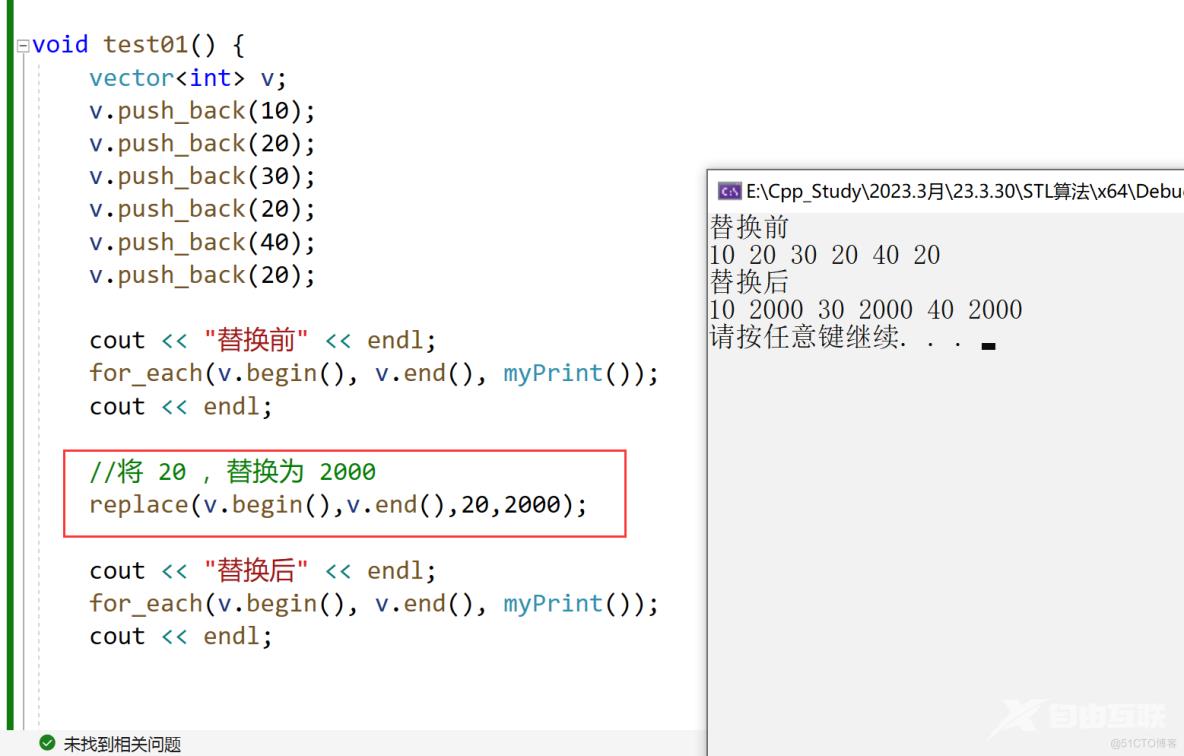
4.3、replace_if
功能描述:
- 将区间内满足条件的元素,替换成指定元素
函数原型:
- replace_if(iterator beg, iterator end, _pred, newvalue);
// beg 开始迭代器
// end 结束迭代器
// _pred 谓词
// newvalue 替换的新元素
示例:
////常用的替换算法 replace_if
class myPrint {
public:
void operator()(int val) {
cout << val << " ";
}
};
class greater10 {
public:
bool operator()(int val) {
return val > 10;
}
};
void test01() {
vector<int> v;
v.push_back(10);
v.push_back(20);
v.push_back(10);
v.push_back(20);
v.push_back(40);
v.push_back(10);
cout << "替换前" << endl;
for_each(v.begin(), v.end(), myPrint());
cout << endl;
//将大于10的,替换为 666
replace_if(v.begin(), v.end(), greater10(), 666);
cout << "替换后" << endl;
for_each(v.begin(), v.end(), myPrint());
cout << endl;
}
int main() {
test01();
system("pause");
return 0;
}
class myPrint {
public:
void operator()(int val) {
cout << val << " ";
}
};
class greater10 {
public:
bool operator()(int val) {
return val > 10;
}
};
void test01() {
vector<int> v;
v.push_back(10);
v.push_back(20);
v.push_back(10);
v.push_back(20);
v.push_back(40);
v.push_back(10);
cout << "替换前" << endl;
for_each(v.begin(), v.end(), myPrint());
cout << endl;
//将大于10的,替换为 666
replace_if(v.begin(), v.end(), greater10(), 666);
cout << "替换后" << endl;
for_each(v.begin(), v.end(), myPrint());
cout << endl;
}
int main() {
test01();
system("pause");
return 0;
}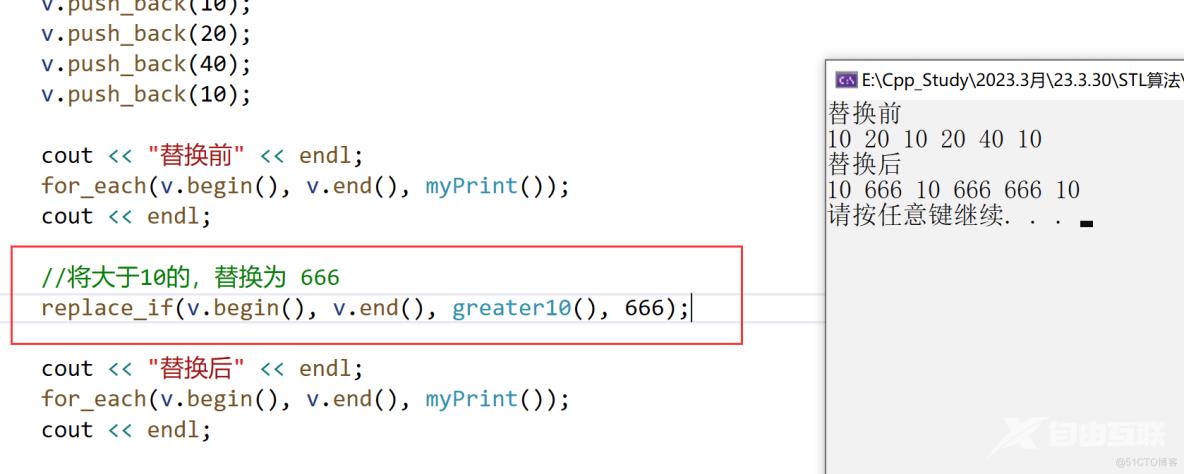
4.4、swap
功能描述:
- 互换两个容器的元素
函数原型:
- swap(container c1, container c2);
// c1 容器1
// c2 容器2
示例:
//常用的替换算法 swap
class myPrint {
public:
void operator()(int val) {
cout << val << " ";
}
};
void test01() {
vector<int> v;
vector<int> v1;
for (int i = 0; i < 5;i++) {
v.push_back(i);
v1.push_back(i+10);
}
cout << "交换前:" << endl;
cout << "v的地址:" << &v[0] << endl;
for_each(v.begin(),v.end(),myPrint());
cout << endl;
cout << "v1的地址:" << &v1[0] << endl;
for_each(v1.begin(),v1.end(),myPrint());
cout << endl;
cout << "交换后:" << endl;
//实现v和v1的交换
swap(v,v1);
cout << "v的地址:" << &v[0] << endl;
for_each(v.begin(), v.end(), myPrint());
cout << endl;
cout << "v1的地址:" << &v1[0] << endl;
for_each(v1.begin(), v1.end(), myPrint());
cout << endl;
}
int main() {
test01();
system("pause");
return 0;
}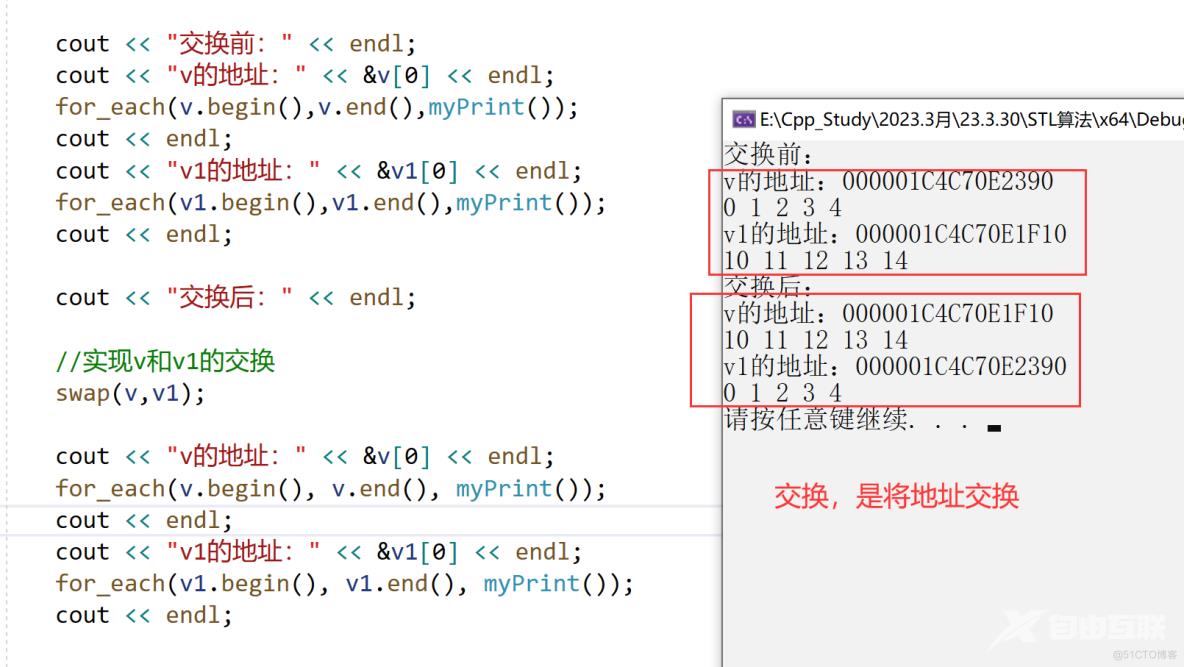
注意事项:
1、swap交换时,发生的是地址交换
2、swap交换时,两个容器需要同种数据类型
5、常用算术生成算法
5.1、accumulate
功能描述:
- 计算区间内 元素累计总和,并将其返回
函数原型:
- accumulate(iterator beg, iterator end, value);
// beg 开始迭代器
// end 结束迭代器
// value 起始值
示例:
//常用的算术生成算法 accumulate
void test01() {
vector<int> v;
for (int i = 0; i <= 100;i++) {
v.push_back(i);
}
int sum = accumulate(v.begin(),v.end(),0);
cout << "vector容器元素之和:" << sum << endl;
}
int main() {
test01();
system("pause");
return 0;
}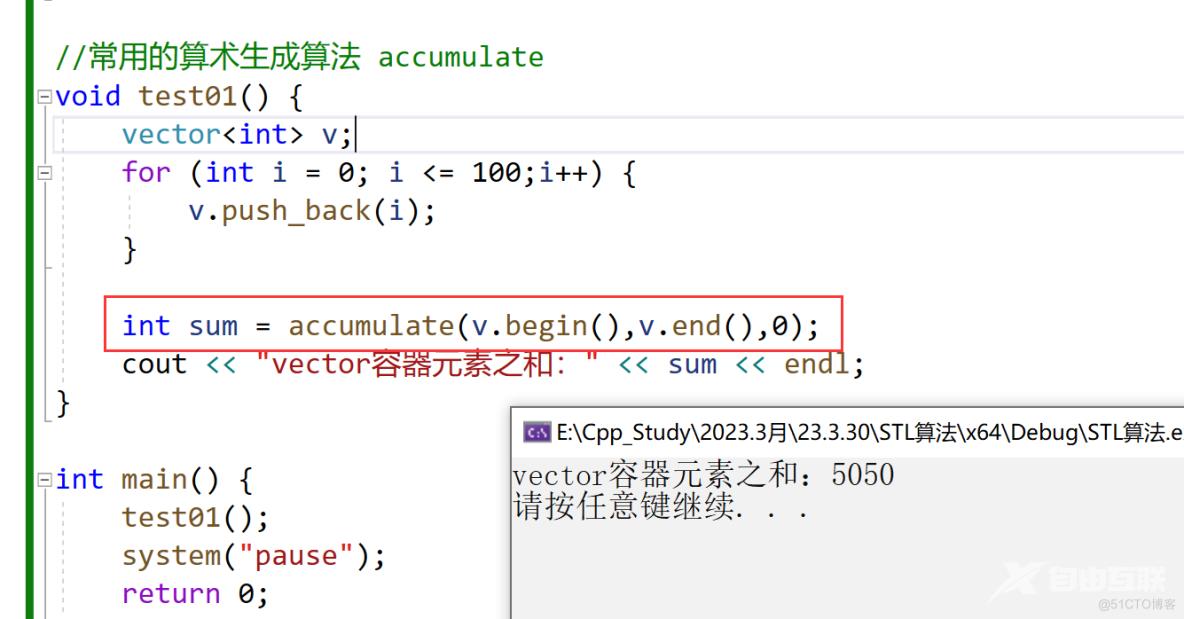
注意事项:accumulate使用时头文件注意是 numeric,这个算法很实用
5.2、fill
功能描述:
- 向容器中填充指定的元素
函数原型:
- fill(iterator beg, iterator end, value);
// beg 开始迭代器
// end 结束迭代器
// value 填充的值
示例:
//常用的算术生成算法 fill
void myPrint(int val) {
cout << val << " ";
}
void test01() {
vector<int> v;
v.resize(10);
for_each(v.begin(),v.end(),myPrint);
cout << endl;
//重新填充为 100
fill(v.begin(),v.end(),100);
for_each(v.begin(), v.end(), myPrint);
cout << endl;
}
int main() {
test01();
system("pause");
return 0;
}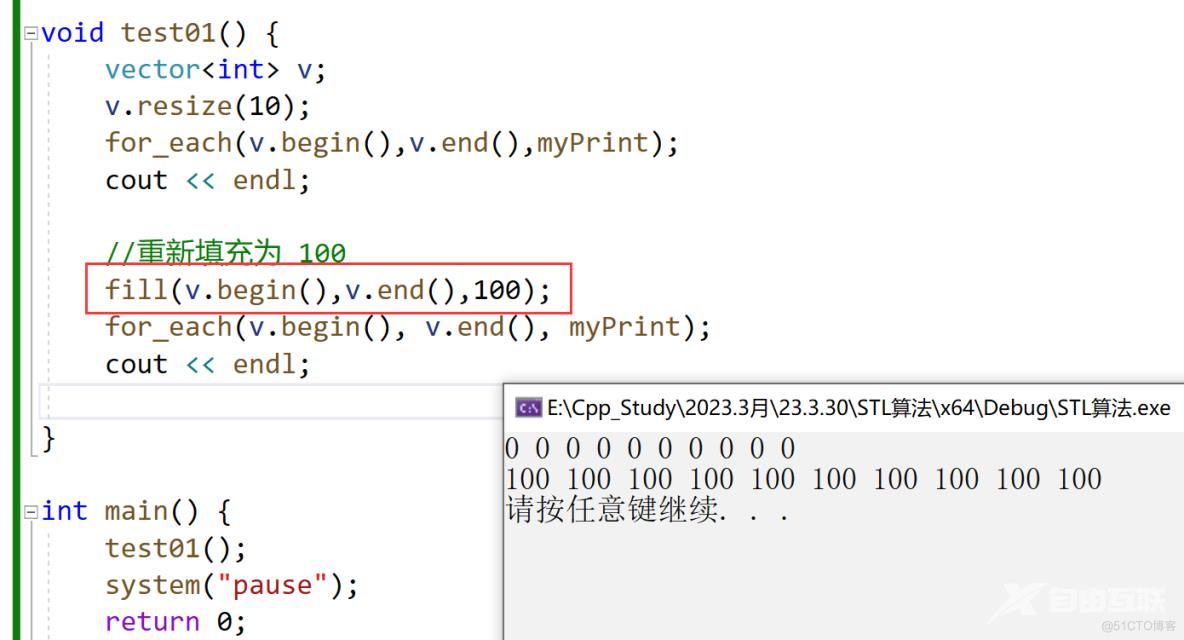
6、常用集合算法
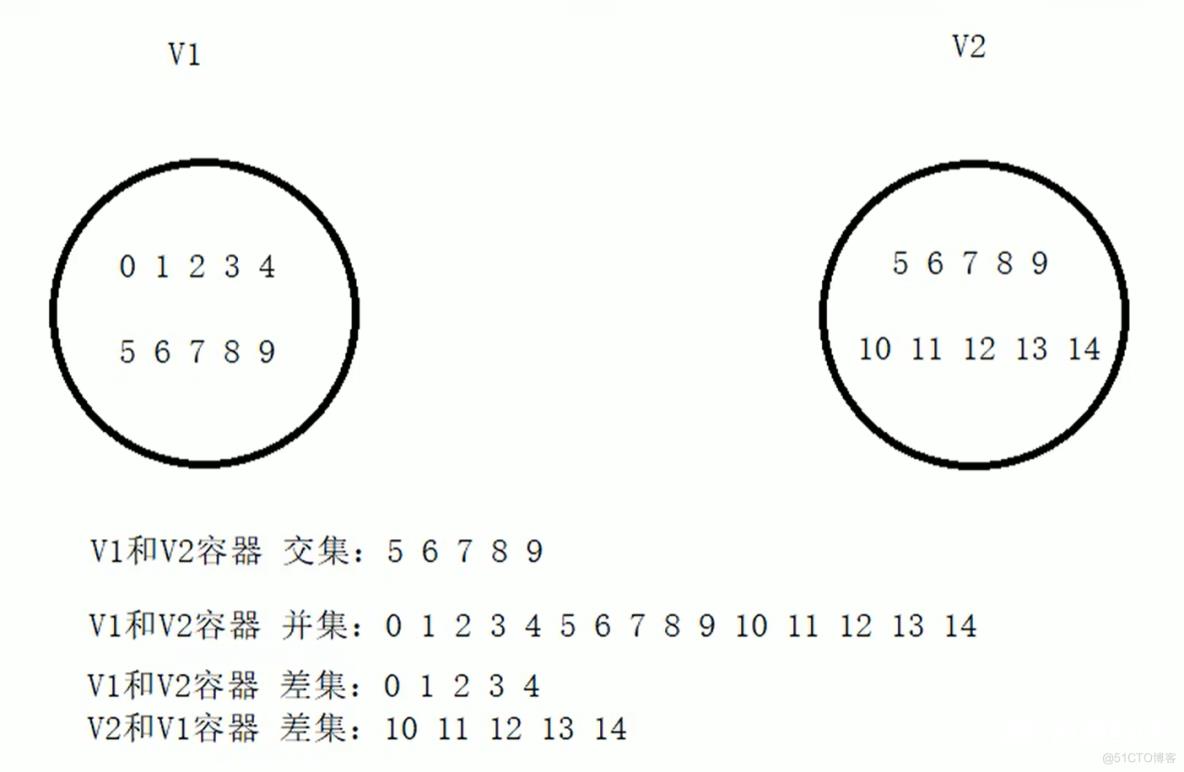
6.1、set_intersection
功能描述:
- 求两个容器的交集
函数原型:
- set_intersection(iterator beg1, iterator end1, iterator beg2, iterator end2, iterator dest);
// beg1 容器1开始迭代器
// end1 容器1结束迭代器
// beg2 容器2开始迭代器
// end2 容器2结束迭代器
// dest 目标容器开始迭代器
示例:
#include<vector>
#include<numeric>
#include<algorithm>
//常用的集合算法 set_intersection(交集)
void myPrint(int val) {
cout << val << " ";
}
void test01() {
vector<int> v1;
vector<int> v2;
for (int i = 0; i < 10;i++) {
v1.push_back(i+1);
v2.push_back(i+6);
}
for_each(v1.begin(),v1.end(),myPrint);
cout << endl;
for_each(v2.begin(), v2.end(), myPrint);
cout << endl;
vector<int> vt;
//需要分配空间,空间大小为两个集合的最小值
vt.resize(min(v1.size(),v2.size()));
//返回值是交集的最后一个元素迭代器
vector<int>::iterator itEnd =
set_intersection(v1.begin(),v1.end(),v2.begin(),v2.end(),vt.begin());
//1、下界迭代器为:v.end()
for_each(vt.begin(),vt.end(),myPrint);
cout << endl;
//2、下界迭代器为:itEnd
for_each(vt.begin(), itEnd, myPrint);
cout << endl;
}
int main() {
test01();
system("pause");
return 0;
}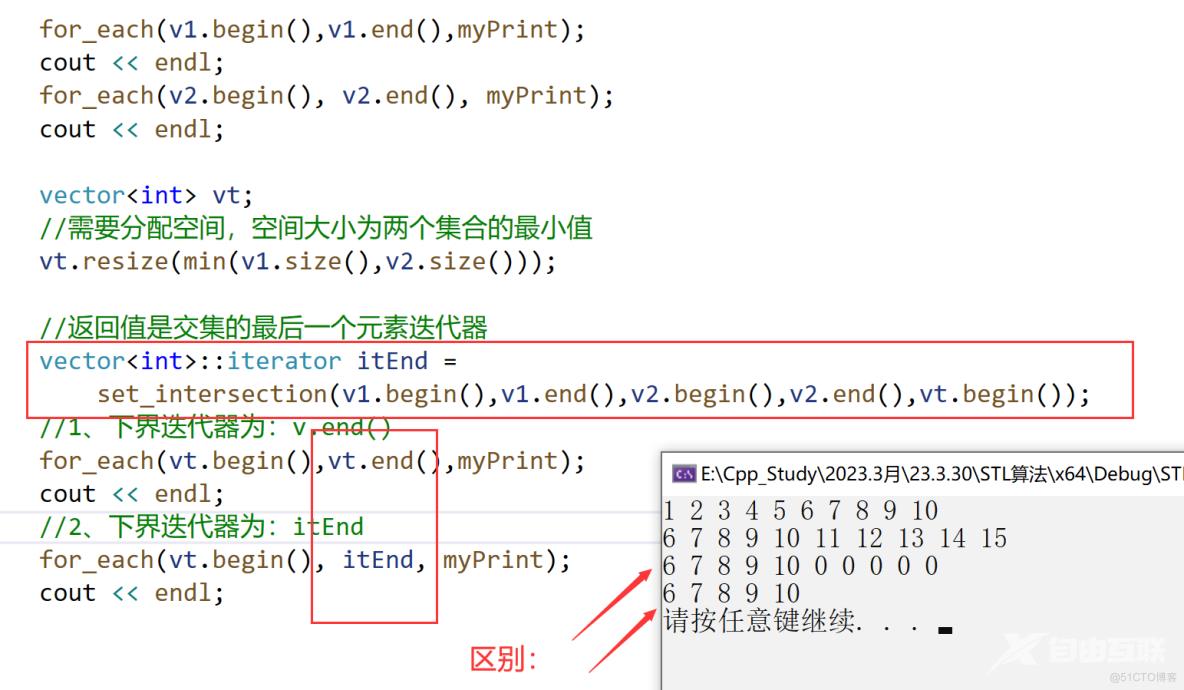
注意事项:
- 求交集的两个集合必须的有序序列
- 目标容器开辟空间需要从两个容器中取小值
- set_intersection返回值既是交集中最后一个元素的位置
6.2、set_union
功能描述:
- 求两个集合的并集
函数原型:
- set_union(iterator beg1, iterator end1, iterator beg2, iterator end2, iterator dest);
// beg1 容器1开始迭代器
// end1 容器1结束迭代器
// beg2 容器2开始迭代器
// end2 容器2结束迭代器
// dest 目标容器开始迭代器
示例:
//常用的集合算法 set_union(并集)
void myPrint(int val) {
cout << val << " ";
}
void test01() {
vector<int> v1;
vector<int> v2;
for (int i = 0; i < 10; i++) {
v1.push_back(i + 1);
v2.push_back(i + 6);
}
for_each(v1.begin(), v1.end(), myPrint);
cout << endl;
for_each(v2.begin(), v2.end(), myPrint);
cout << endl;
vector<int> vt;
//需要分配空间,空间大小为两个集合大小之和
vt.resize(v1.size()+v2.size());
//返回值是并集的最后一个元素迭代器
vector<int>::iterator itEnd =
set_union(v1.begin(), v1.end(), v2.begin(), v2.end(), vt.begin());
//1、下界迭代器为:v.end()
for_each(vt.begin(), vt.end(), myPrint);
cout << endl;
//2、下界迭代器为:itEnd
for_each(vt.begin(), itEnd, myPrint);
cout << endl;
}
int main() {
test01();
system("pause");
return 0;
}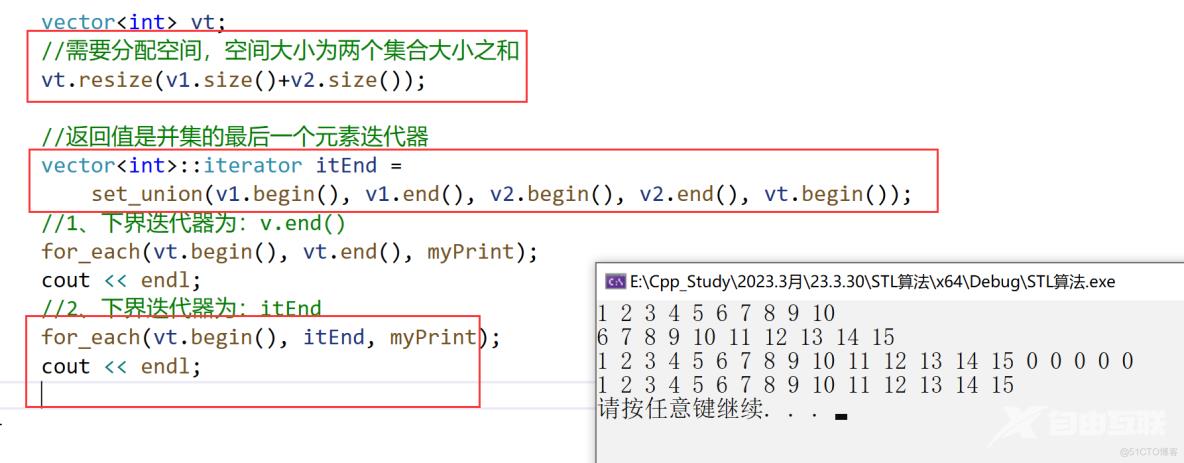
注意事项:
- 求并集的两个集合必须的有序序列
- 目标容器开辟空间需要两个容器相加
- set_union返回值是并集中最后一个元素的位置
6.3、set_difference
功能描述:
- 求两个集合的差集
函数原型:
- set_difference(iterator beg1, iterator end1, iterator beg2, iterator end2, iterator dest);
//beg1 容器1开始迭代器
// end1 容器1结束迭代器
// beg2 容器2开始迭代器
// end2 容器2结束迭代器
// dest 目标容器开始迭代器
示例:
//常用的集合算法 set_difference(差集)
void myPrint(int val) {
cout << val << " ";
}
void test01() {
vector<int> v1;
vector<int> v2;
for (int i = 0; i < 10; i++) {
v1.push_back(i + 1);
v2.push_back(i + 6);
}
for_each(v1.begin(), v1.end(), myPrint);
cout << endl;
for_each(v2.begin(), v2.end(), myPrint);
cout << endl;
vector<int> vt;
//需要分配空间,空间大小为两个集合的最大值
vt.resize(max(v1.size(),v2.size()));
// 1、v1 和 v2 的差集
//返回值是并集的最后一个元素迭代器
vector<int>::iterator itEnd =
set_difference(v1.begin(), v1.end(), v2.begin(), v2.end(), vt.begin());
cout << endl;
//下界迭代器为:itEnd
cout << "v1 和 v2 的差集:" << endl;
for_each(vt.begin(), itEnd, myPrint);
cout << endl;
//1、 v2 和 v1 的差集
itEnd =set_difference(v2.begin(), v2.end(), v1.begin(), v1.end(), vt.begin());
cout << endl;
//下界迭代器为:itEnd
cout << "v2 和 v1 的差集:" << endl;
for_each(vt.begin(), itEnd, myPrint);
cout << endl;
}
int main() {
test01();
system("pause");
return 0;
}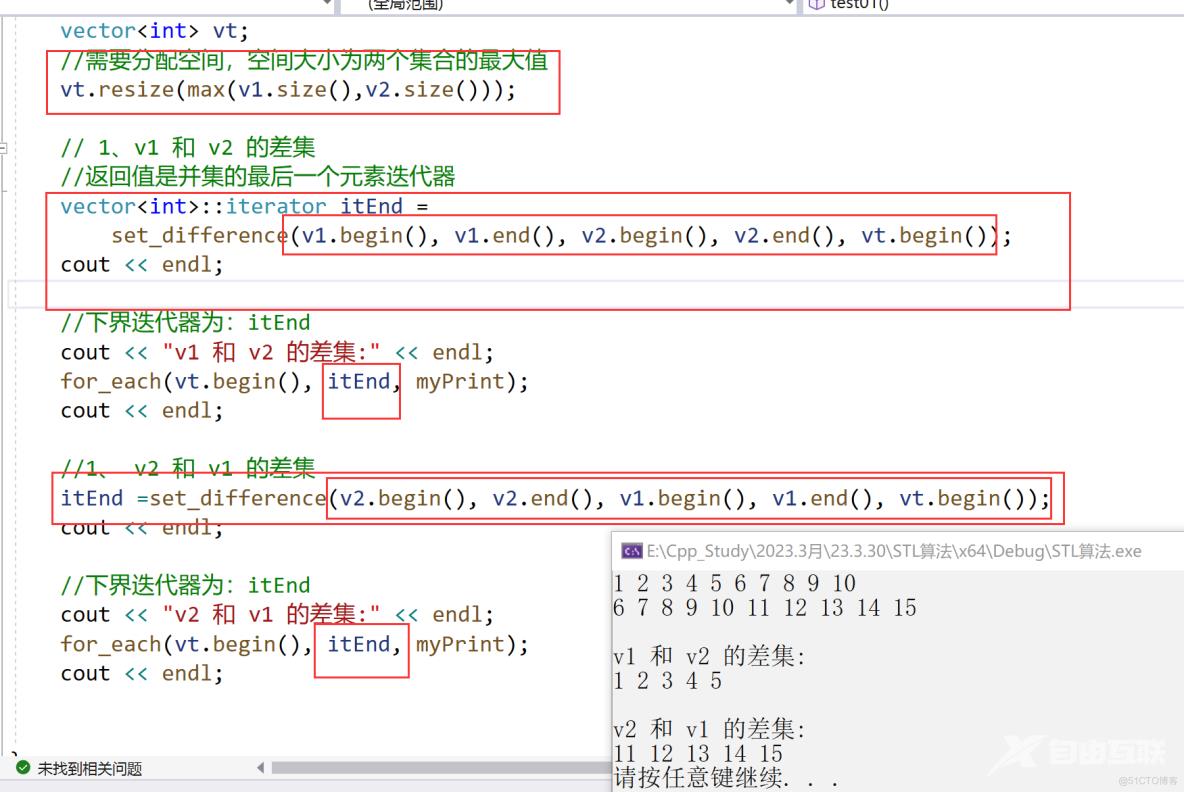
注意事项:
- 求差集的两个集合必须的有序序列
- 目标容器开辟空间需要从两个容器取较大值
- set_difference返回值是差集中最后一个元素的位置
